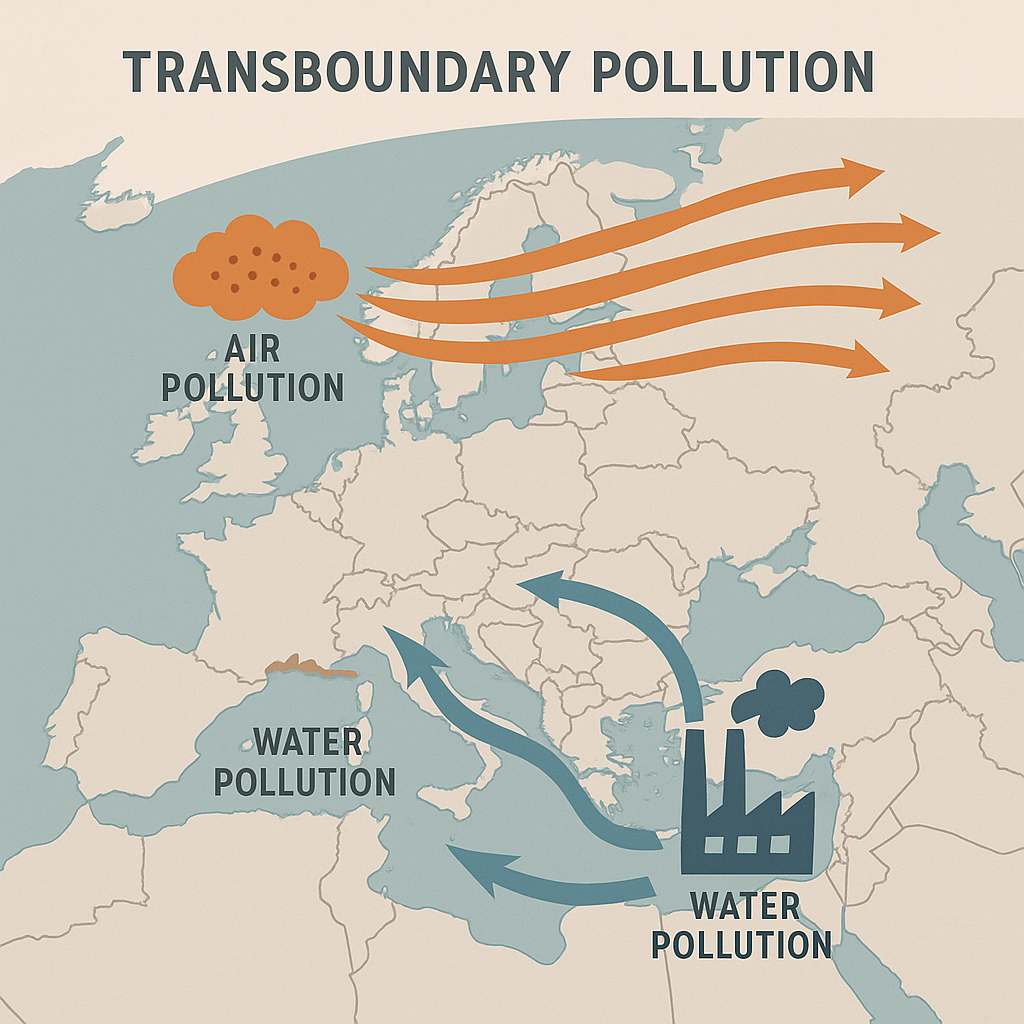Discover how borderless thinking can unlock smarter, fairer solutions to today’s global environmental crises.

Imagine this: The Danube River, Europe’s second-longest, winds through ten countries – rising in Germany, passing through Austria, Hungary, and Romania – before spilling into the Black Sea. A flood upstream caused by extreme rainfall in Central Europe doesn’t stop at any border; it surges downstream, affecting cities and farmland in nations hundreds of kilometres away. Or consider the Saharan dust storms that sweep north across the Mediterranean, blanketing Spain, France, and even parts of the UK in fine orange particles. These aren’t isolated events – they’re stark reminders that environmental problems ignore the lines humans draw on maps.
Climate change, biodiversity loss, pollution, and resource depletion are inherently transboundary. They spill across national boundaries, disrupt multiple regions simultaneously, and link people through shared consequences. In this context, borderless thinking becomes not just visionary- but necessary.
Borderless thinking is the practice of solving problems at the scale of real-world flows—rivers, airsheds, species, supply chains—by coordinating governance, data, and finance beyond political borders.
This post explores how this mindset helps us better understand and respond to environmental risks through:
- Recognising that environmental degradation ignores borders
- Embracing systems thinking to map complex interdependencies
- Encouraging international and cross-regional cooperation
- Reimagining justice and responsibility beyond geography
- And showcasing real-world solutions driven by borderless collaboration
Environmental Problems Know No Borders

The planet doesn’t organise itself by passports or checkpoints. Air pollution travels on wind currents. Wildlife migrates across continents. Climate disasters cascade across economies and ecosystems, often starting in one region and devastating another. The environmental crises we face are fundamentally borderless.
Citizen science and peer-reviewed research provide overwhelming evidence of these spillover effects. For example, a study published in Science of the Total Environment documents how transboundary air pollution significantly impacts public health and ecosystems across Europe, highlighting the urgent need for coordinated, cross-border environmental strategies. Despite this, most environmental policies remain confined within national borders. Regulations on emissions, land use, or conservation are often developed in silos – rarely accounting for the full scope of environmental interconnectivity.
To truly address climate risks, we must think and act beyond borders – scientifically, politically, and morally. Only by aligning policy frameworks with the shared nature of these threats can we begin to build sustainable solutions that reflect the realities of a deeply connected world.
Systems Thinking: Mapping Complexity Across Borders
Environmental problems don’t exist in isolation – they’re part of vast, dynamic systems that stretch across ecosystems, economies, and societies.
Systems thinking is a holistic approach that helps us understand the interconnectedness of environmental, political, and social systems. Rather than tackling symptoms, it looks at how problems interact over time – uncovering hidden feedback loops, unintended consequences, and leverage points where interventions can trigger significant change. It has become a powerful tool in areas like climate adaptation, sustainable agriculture, and biodiversity protection, especially in transboundary contexts. For example, climate models that integrate energy, water, and food systems across regions help policymakers better prepare for extreme events that affect multiple countries at once.
Cross-Border Cooperation: Models That Work
In Europe, the European Union’s Interreg and related regional programmes are established mechanisms for environmental collaboration. These initiatives have enabled joint water management in transboundary river basins, coordinated climate adaptation strategies, and fostered cross-border biodiversity corridors. According to a peer-reviewed review published by Springer, these efforts not only support ecological sustainability but also build mutual trust and institutional capacity in border regions facing shared risks.
This is echoed in broader contexts as well. For instance, coordinated efforts in international river basin management, like those involving the Rhine and Danube, show how countries with distinct political systems and histories can collaborate effectively on shared ecological goals when there is strong institutional design and mutual accountability.
The bottom line? Political borders don’t need to block environmental progress. With the right frameworks and cooperative mindset, nations and regions can come together to tackle shared challenges – proving that borderless thinking isn’t just theoretical. It’s already in motion.
Rethinking Borders Through the Lens of Justice

Borders are more than lines on a map – they determine who gets help, who is left out, and who pays the price for environmental breakdown. As climate change intensifies floods, droughts, and sea-level rise, millions of people are being forced to migrate. Yet those who contribute the least to climate change often face the harshest barriers to mobility.
Scholarly work on climate justice and environmental displacement argues that strict border regimes amplify global inequality and deny basic rights to climate-affected communities. From refugee policies to visa restrictions, current systems prioritise national interest over shared global responsibility.
Borderless thinking challenges this by promoting a justice-based, rights-oriented lens. It calls for climate-responsive migration frameworks that protect the displaced, and for resource-sharing mechanisms that recognise historical emissions and distribute aid accordingly. This isn’t about erasing borders – but reimagining them to reflect empathy, equity, and mutual responsibility in a warming world.
Real-World Impact: When Borderless Thinking Is Applied
Borderless thinking is already driving real-world environmental progress. From shared river basin management and migratory species corridors to international climate agreements, cross-border collaboration improves resilience, prevents conflict, and fosters innovation. The key: harmonise regulations, empower local actors, and invest in long-term regional institutions. The result? More sustainable, inclusive, and effective environmental solutions.
The path forward is cooperation, not isolation.
➤ Explore more here: Frontiers in Integrative Neuroscience – Systems Thinking in an Era of Climate Change
Note: The images in this article were created using AI tools to help illustrate key ideas. We use these visuals to make the content more engaging and accessible while keeping the message clear and accurate.

Leave a Reply